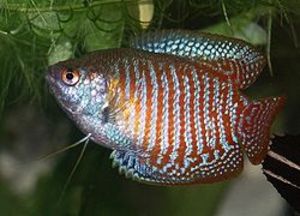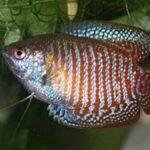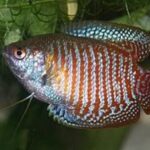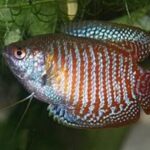Gouramis make excellent fish for the novice tropical fish keeper. This is not said to offend any gouramis that happen to be reading this. It is very difficult to keep any fish happy and healthy, so you might as well start off with fish that are not only easy to feed and forgiving of minor husbandry errors, but are beautiful, too.
So Many Gouramis, So Little Time
There are over a dozen varieties of gouramis in the pet trade, but about six that are far more easily available than others. These include:
• The Pearl Gourami
• The Dwarf Gourami
• The Dwarf Flame Gourami
• The Moonlight Gourami
• The Opaline Gourami
• The Giant Gourami (can be difficult to get)
• The Chocolate Gourami
• Kissing Gouramis
All of these varieties stay relatively small, but the aptly named Giant Gourami grows to over two feet long (which isn’t that big in comparison to many other kinds of full-grown tropical fish, nut nig in comparison to other gouramis) Chocolate gouramis are not recommended for the home aquarium, as they die very easily.
Part of caring for gouramis is knowing which to choose and which to keep back at the pet store or fish show. You are best off getting just one variety of gourami for your tank. Although gouramis are usually peaceful, they can become very aggressive towards other fish, especially angelfish, bettas and other gouramis. Gouramis usually get along with tetras, danios, Chinese algae eaters and plecostomus. If you have other fish in the tank, make sure there are plenty of places for them to hide should you bring home Psycho Gourami.
You never want to overcrowd your tank. This leads to stressed out fish that can’t get enough nutrients and leads to a tank that needs to be cleaned a lot more often. As a general rule, you should have at least four gallons per inch of fish.
Feeding And Water
Gouramis are not picky eaters. They can thrive on commercial flakes for tropical fish (not goldfish), pellets and freeze-dried foods. They will also eat some of the algae in your tank, but can’t live entirely on it. They also enjoy frozen bloodworms, brine shrimp and lettuce leaves as a treat. Make sure the lettuce leaves are thoroughly washed before putting in your tank. Any residual pesticides on the leaves could kill the fish.
You need to pay attention to the quality of the water your fish live in. After all, its their whole world. Any chemicals in the water will be absorbed into your fish’s body through the skin. Gouramis like a water temperature of around 72 to 82 degrees Farenheight. Make sure you have your water tested for chemical problems such as too much ammonia before adding any fish.
Once a week, or more if necessary, you need to do a partial water change. You just siphon out a fourth or a fifth of the tank water and then add new water. Be sure the water is treated if it needs to be. Also, make sure the water is room temperature, so it doesn’t change the temperature in the tank too much. Gouramis are tough, but do not like sudden temperature changes.
References:
“Freshwater Aquarium Problem Solver.” David E. Boruchowitz. TFH Publications; 2006
Wikipedia. “Gourami.” http://en.wikipedia.org/wiki/Gourami
Aqualand Fact Sheets. “How to Care for Chocolate Gouramis.” http://aqualandpetsplus.com/Gourami%2C%20Chocolate.htm
Author kept dwarf gouramis in the 1990s.






